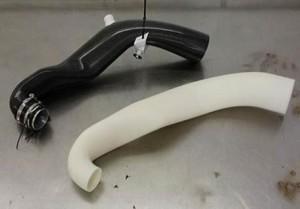Champion Motorsport builds a line of aftermarket performance products for Porsche automobiles, and their line includes turbo inlet ducts for the Porsche 997.
The 997 comes straight from the factory as a very, very fast machine. A number of American automotive publications say turbo models can go from 0 to 60 in around 3.4 seconds and they can reach a top speed of 180 mph. But for some people, that’s just not fast enough.
Naveen Maraj, the President of Champion Motorsport, says his company develops its own brand of ultra-light wheels and carbon composite intakes. The company’s in-house engineering team designs, engineers, develops, and tests the exhaust products at their 22,000-square-foot complex in Florida.
 To optimize performance, Champion makes inlet ducts from carbon fiber, and they use that material for its strong, thin, and lightweight characteristics. Using carbon fiber allows engineers to increase the interior dimensions of the ducts while maintaining the outer dimensions required by factory specifications, and the building for more interior space in the ducts means better airflow, and that adds up to improved overall engine performance.
To optimize performance, Champion makes inlet ducts from carbon fiber, and they use that material for its strong, thin, and lightweight characteristics. Using carbon fiber allows engineers to increase the interior dimensions of the ducts while maintaining the outer dimensions required by factory specifications, and the building for more interior space in the ducts means better airflow, and that adds up to improved overall engine performance.
But the team at Champion found that they were frustrated when it comes to traditional manufacturing methods. There were confronted with a Hobson’s Choice; sacrifice either optimum air flow or pleasing aesthetics.
So the engineers at Champion turned to 3D printing to create “soluble molds” to build their intakes.
The problem was that conventional tooling methods failed to produce a duct that was both perfectly smooth on both the interior and exterior surfaces. The previous methods of construction meant ducts were molded in two parts and then bonded together. That meant the part would be weaker than a duct made of a single piece.
 Making the part from a single piece meant using a sacrificial sand core, and that process resulted in a surface finish which just didn’t meet aesthetic requirements for such high-end parts.
Making the part from a single piece meant using a sacrificial sand core, and that process resulted in a surface finish which just didn’t meet aesthetic requirements for such high-end parts.
So Chris Lyew, the lead mechanical engineer at Champion, says his team used the Stratasys Fortus 3D Production System and an FDM-based Stratasys 3D printer to take on the task of molding the carbon fiber by producing FDM soluble cores.
The molds they came up with can be wrapped 360º in carbon, eliminating the need for any seams in the finished part. Builders use a solution to help remove the mold, and it leaves behind a perfectly smooth pipe. Lyew called it “the magic recipe.”
“At the end of the day, the FDM technologies – they save us time; they save us money,” says Louis Malone, the Technical Director at Champion Motorsport.
 The team at Champion say the 3D printing process creates a mold made of a special soluble support material. That mold is wrapped completely in carbon, and once wrapped, the completed part is submerged in a solution which dissolves the soluble support to leave only the finished carbon piece behind.
The team at Champion say the 3D printing process creates a mold made of a special soluble support material. That mold is wrapped completely in carbon, and once wrapped, the completed part is submerged in a solution which dissolves the soluble support to leave only the finished carbon piece behind.
Custom car and motorcycle buildings are using 3D printing processes to give their vehicles aesthetic beauty and a performance edge. Do you know about any car or motorcycle companies who’ve made something out of the ordinary with 3D printing? Let us know in the Making the Porsche 997 Faster With 3D Printing forum thread on 3DPB.com.
Subscribe to Our Email Newsletter
Stay up-to-date on all the latest news from the 3D printing industry and receive information and offers from third party vendors.
You May Also Like
Precision at the Microscale: UK Researchers Advance Medical Devices with BMF’s 3D Printing Tech
University of Nottingham researchers are using Boston Micro Fabrication‘s (BMF) 3D printing technology to develop medical devices that improve compatibility with human tissue. Funded by a UK grant, this project...
3D Printing Webinar and Event Roundup: April 21, 2024
It’s another busy week of webinars and events, starting with Hannover Messe in Germany and continuing with Metalcasting Congress, Chinaplas, TechBlick’s Innovation Festival, and more. Stratasys continues its advanced training...
3D Printing Webinar and Event Roundup: March 17, 2024
It’s another busy week of webinars and events, including SALMED 2024 and AM Forum in Berlin. Stratasys continues its in-person training and is offering two webinars, ASTM is holding a...
3D Printed Micro Antenna is 15% Smaller and 6X Lighter
Horizon Microtechnologies has achieved success in creating a high-frequency D-Band horn antenna through micro 3D printing. However, this achievement did not rely solely on 3D printing; it involved a combination...






























